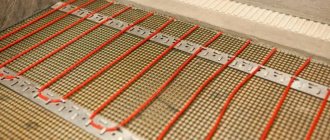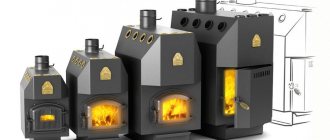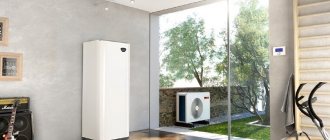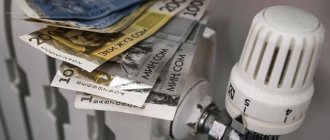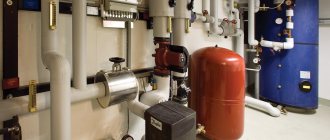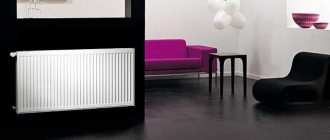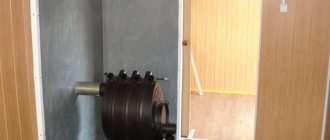Calculation methods
The price for heating is calculated in the following ways:
- if there is no communal meter, according to consumption standards, according to formulas 1, 2, 3, 4;
- if the apartment building has a general building metering apparatus, but none of its premises has individual meters - according to formulas 7, 11;
- if the apartment building is equipped with a common building meter, and one or more of its premises (but not all) has an individual meter - according to formulas 7, 11;
- in an apartment building, in which a common house accounting apparatus is installed, and all premises are equipped with individual devices, according to formulas 10, 11;
- in a private house in which an individual meter is installed - according to formulas 11, 12;
- in an apartment building with a common building meter, despite the fact that more than half of the premises have heat energy distributors - according to formulas 7, 11, and is also adjusted once a year according to formula 5. Homeowners at a general meeting can appoint more frequent adjustments. In the event of equipment breakdown or violation of the integrity of seals, the premises are treated as if they do not have switchgear.
The volume of consumed heat energy when paying for heating during the heating season, if the apartment building is equipped with a common house meter and an open system (natural circulation) is used, is calculated according to the following system: the volume of consumed heat energy is equal to the difference between the volume of consumed heat energy according to the data of the common house meter and the product of the volume of heat energy used for hot water supply. The volume of heat energy for hot water is calculated according to the standard heat energy consumption for hot water supply, and the volume of hot water used by the apartment building for general house needs.
If metering devices for heating and hot water in an apartment building are installed separately, and the calculation is carried out during the heating season, then the price for heating is calculated according to the standard scheme.
When paying for heat energy during the heating season, the amount of heat energy calculated according to the readings of individual metering devices is used only for those periods for which the meter readings were transmitted by consumers. When paying for heat energy evenly throughout the year, the readings of individual metering devices are used when adjusting the readings for the past year.
If an individual heating meter was installed earlier than three months ago, then the payment for heat energy is calculated based on the standards in the same case, but if the apartment building has a common building meter, then the payment is calculated according to the rules for houses with common building meters.
If, during the verification of previously submitted information about the readings of individual metering devices, inaccuracies or malfunctions in the operation of the devices were discovered (including violations of the integrity of the seals), the verification contractor must provide the consumer with a recalculation of the cost of services, as a result of which an additional charge will be made or the overpaid funds will be written off due to subsequent periods.
Calculation example
We have one last option left, during which we will consider the situation when the house does not have a heat meter. The calculation, as in previous cases, will be carried out according to two categories (thermal energy consumption per apartment and ADN).
Option 3
As in the second option, the payment will depend on whether your home is equipped with an individual heat meter. Now it is necessary to find out the amount of heat energy that was spent on general house needs, and this must be done according to formula No. 15 (volume of services for one-room service) and No. 10 (amount for heating).
May 11, 2021 uristgd 98
Share this post
- Related Posts
- Court Order Execution
- A large family may be denied benefits for housing and communal services due to debt
- Okved-2 Retail Trade of Toys Decoding 2021
- Deadlines for Payment of Transport Tax in Novosibirsk in 2021
Why do we pay for heat supply in EPD in summer?
The Unified Payment Document (UPD) contains accounts for various sectors of the housing sector, including utility costs for the use of heat in the summer. Tenants justifiably have a question: why do I pay for heat supply in the summer, while the heating season is within autumn-spring.
The legislation of the Russian Federation allows for the collection of payments for heat supply in two ways:
- in equal monthly installments;
- only in winter.
Most often, management companies use the first method, since it allows the monthly payment amount to be “spread out” evenly. When accrued using the second method, the costs of the home budget during the heating season will increase significantly, and the rest of the time will not be charged.
You cannot blindly trust the amounts written on the receipt. If there are any doubts about the integrity of housing and communal services representatives, it is best to make independent simple calculations using a calculator using the above calculation methods. If a discrepancy is identified, contact the utility company with a request to issue an invoice again.
Option 1
So, the house is equipped with a control device, but some rooms are left without it
Here it is necessary to take into account two positions: calculating Gcal for heating an apartment, the cost of thermal energy for general house needs (GCA)
In this case, formula No. 3 is used, which is based on the readings of the general metering device, the area of the house and the footage of the apartment.
Calculation example
Let's assume that the controller has recorded the house's heating costs at 300 Gcal/month (this information can be found from the receipt or by contacting the management company). For example, the total area of the house, which consists of the sum of the areas of all premises (residential and non-residential), is 8000 m² (you can also find out this figure from the receipt or from the management company).
Let’s take an apartment area of 70 m² (indicated in the registration certificate, rental agreement or registration certificate). The last figure on which the calculation of payment for consumed heat depends is the tariff established by the authorized bodies of the Russian Federation (indicated in the receipt or find out from the house management company). Today the heating tariff is 1,400 rubles/gcal.
Substituting the data into formula No. 3, we get the following result: 300 x 70 / 8,000 x 1,400 = 1,875 rubles.
Now you can move on to the second stage of accounting for heating costs spent on the general needs of the house. Here you will need two formulas: searching for the volume of service (No. 14) and payment for the consumption of gigacalories in rubles (No. 10).
For example, we have a total area of 7000 m² (including apartments, offices, retail premises.).
Let's start calculating the payment for thermal energy consumption using formula No. 14: 300 x (1 – 7,000 / 8,000) x 70 / 7,000 = 0.375 Gcal.
Using formula No. 10, we get: 0.375 x 1,400 = 525, where:
- 0.375 – volume of service for heat supply;
- 1400 rub. – tariff;
- 525 rub. - amount of payment.
We sum up the results (1875 + 525) and find out that the payment for heat consumption will be 2350 rubles.
Scheme No. 3. If both the house and apartment are equipped with heat consumption meters
We continue to consider the standard for thermal energy consumption for heating. Having two meters is considered perhaps the most economical option, since you will only pay for the heat that is actually supplied to the apartment, and not vague standards. To get the total amount, in this case you need to add the heat energy consumption in the apartment to the readings of the common building meter (similarly divided between residents).
Scheme No. 1. There is no individual meter, but there is a communal metering device
And the last thing is the definition of a circulation pump. In order for the coolant to be evenly distributed throughout the heating system, it is necessary that its speed be no less than 0.25 m/sec and no more than 1.5 m/sec. In this case, the pressure should not be higher than 20 MPa. If the coolant velocity is higher than the maximum suggested value, the pipe system will operate noisily. If the speed is lower, airing of the circuit may occur.
But the main difficulty lies not even in the units of measurement. The calculation involves the use of many formulas, the application of which depends on many factors, for example, on whether there are accurate heat metering devices in the heating system of the house. It seems appropriate to consider all these conditions and options further.
More to read —> Okof Information Stands 2021 This is Machinery and Equipment Or What?
The cost of heating services per 1 sq. m in Gcal in 2021 in an apartment building
Heating charges vary from region to region. The maximum indicators (which, of course, are in demand) are set by the regional administration, as a rule, for every six months. Plus, the formulation “heating price per 1 kW per m²” is not correct - government authorities limit the cost of the gigacalorie itself consumed by a utility unit.
After all, a gigacalorie is an analogue of a unit of work (the same Joule or kilowatt-hour), simply having a larger scale for convenience. For example:
- 1 gigacalorie corresponds to 4,184,000,000.00 Joules (4.184 gJ);
- 1 gigacalorie corresponds to 1,162.22 kilowatt-hours (kWh).
It is convenient to account for heat in gigacalories due to the large scale of thermal energy consumption (heat has an extremely high energy density compared, for example, with the same mechanical work).
These standards vary greatly among different regions due to the fact that temperature climatic regimes also differ significantly between them (winter in the Stavropol region is one thing and quite another in Anadyr). In addition, even within the same region (subject of the Federation) there may be several types of standards, depending on the quality of the house for which this standard is applied.
If this is a wooden barracks built in the 50s of the last century, then it will require more energy to maintain a comfortable temperature environment than in more modern multi-story buildings.
The standard is set specifically for 1 m² of living space, that is, there is a link: the larger your apartment, the more you will have to pay for heat if standard coefficients apply, regardless of how effective the thermal insulation is in your home.
Understanding this, the state administration seeks to create conditions and stimulate the process of equipping all consumers with individual heat meters, that is, at a minimum, to install communal heat meters.
However, there are a number of limitations:
- Now an individual metering device for an apartment (in houses built before 2012) is installed if there is a centralized supply from a single riser. If there are several pipes, then the installation of an IPU is considered physically impossible at this stage due to the need to install a large number of meters (for each battery), the high cost of the process and the complexity of accounting. Apartment buildings put into operation after 01/01/2012 (as a new building or after a major overhaul) are required by law to be equipped with individual and communal heat meters.
- Also, sometimes technical difficulties arise that make it impossible to install a common house metering device (CDMU).
In these cases, accounting is carried out in accordance with the standards. But if it is technically possible to install IPU and ODPU, and consumers still prefer to remain on the standard system of charging for heat supply, then penal increasing coefficients already begin to apply (you can learn how to decipher KPU, IPU and other abbreviations in the receipt for housing and communal services find out here).From 01/01/2017, this increasing coefficient is equal to 1.1 to the fee set by the heat supply organization. The very cost of 1 Gcal per 1 square meter in each region, of course, will be different.
Calculating the heating power of a cottage - how to do it right
Heating a private home » Heating installation » Calculation of heating systems
How to determine heating power
If you have built your own house and are ready to begin constructing utility networks, you need to familiarize yourself with some of the nuances that will affect the correctness of the installation work. Let's talk about the heating system. And let's start with calculating the heating of the room.
It would seem that you can count on this - buy a boiler, pipes and radiators, install and connect it all. But it's not that simple. After all, you will have to invest your own money. A properly calculated system will save a lot of money.
Heating boiler calculation
This is the simplest of calculations, because the power of the heating boiler depends on the area of the premises that it will heat. To do this, take the ratio - 1 kilowatt of thermal energy heats 10 square meters of area with a ceiling height of no higher than 3 meters. Take the total area of the house, divide by 10 and get the power of the heating boiler.
This simplified formula can only be used for single-circuit devices. For a double-circuit unit, the calculation will have to be done differently. For example, a house with an area of 240 square meters cannot be heated with a wall-mounted boiler with a capacity of 24 kilowatts. One heating circuit will work to heat the premises, and the second will heat water for domestic needs. Therefore, the power will have to be divided by 2, and it turns out that such a boiler can heat a house with an area of no more than 120 square meters.
However, experts recommend purchasing boilers with higher power to create a small reserve - 10-15% is enough. True, much will depend on the height of the ceilings.
With a single-circuit device everything is much simpler, but even here a small backlog is needed. For example, by choosing a single-circuit boiler with a capacity of 24 kilowatts, you can guarantee that it will easily heat a house with an area of 200 square meters with a ceiling height of 2.5-2.6 meters. If the ceilings in the house are 3 meters, then the device will be able to heat rooms with a total area of 170 square meters. These are the manipulations.
Calculation of heating radiators in an apartment is also very important. And here you will first have to determine their number, and for each room separately. To do this, you need to take as a basis not area, but cubic capacity. If there are few batteries, this will ensure a lack of heat, which means the rooms will always be cold. If there are too many radiators, then you will have to pay more for such heat by purchasing more fuel. So everything should be in moderation.
The calculation of heating radiators is conventionally divided into two stages:
- Determining the total number of sections required for efficient heating of the room.
- Determining the number of radiators.
In this case, you will have to take into account the heat transfer rates of the devices that you have chosen for installation in the house. Let's look at one simple example that will show how to count the number of radiators.
Alternative connection of heating radiators in an autonomous system
For example, let's take a room with an area of 10 square meters with a ceiling height of 3 meters. There is a standard indicator that determines the amount of thermal energy that is enough to heat 1 cubic meter of space. It is equal to 39-41 watts. To calculate the volume of a room, you need to multiply the area by the height of the room - in our example it is 30 cubic meters. Now we multiply this value by 41 watts. The result is 1230 watts. This is the power that will pull the volume of a given room.
There is another standard indicator - this is the amount of thermal energy that 1 radiator section can generate. It is equal to 200 watts. Now we divide the resulting total power by the power of one section -1230/200=6.15. This is the required number of sections that need to be rounded up. The result is the number “7”. This means that in this room you can install a radiator with seven sections. It's that simple.
For corner rooms, the calculation of cast iron batteries is carried out using an additional correction factor, which depends on the region. The coefficient is 1.1-1.3. To avoid mistakes, take the maximum indicator as a basis. The formula will be like this - 1230x1.3/200=7.995. Round up to 8.
Attention! In our case, the number of sections is not so large. Sometimes this number goes beyond a couple of dozens. For such cases, the advice is to divide the number of sections into an equal number of batteries, installed evenly throughout the building and ideally under the window.
Calculation of other heating materials
For those who have never encountered the installation of a heating system, it will be very difficult to calculate the necessary materials. The minimum that is needed is to at least have an idea of how the pipes will be laid out, how the heating boiler will be wired, and how the batteries will be connected. Therefore, before you start counting, it is necessary to study the operating diagram of the heating system. If you cannot cope with this, then it is better to contact specialists.
Radiator connection diagrams
What materials are needed for a heating system? Let's look at them using the example of a double-circuit boiler. To connect it to the home heating system, you will need at least four ball valves with detachable connections - one for each input and output of the two circuits. Each tap has one threaded adapter to connect it to the pipelines. You will definitely need two filters for mechanical purification of the water entering the boiler.
Now let's move on to tying the radiators. Here you need two valves (regulating and shut-off), a Mayevsky valve (for bleeding air), a plug, two threaded adapters and two tees for connecting the pipes to the main line. And this is a kit for only one radiator. To calculate all the necessary products, you will have to multiply this by the number of batteries that are planned in your home.
As for the pipes, you will have to measure the distances from the radiators to the boiler and multiply the resulting footage by two. Because many systems operate on the principle of coolant supply and return. The only problem may arise with the diameters of the pipelines, but not everything is so complicated here. Many systems mainly use pipes from 20 to 32 millimeters in diameter. And if your house is not very large in size, then this figure will be sufficient.
Conclusion on the topic
As you can see, calculating the heating power of a cottage is a serious matter. Here it is necessary to take into account many parameters of the house itself. But in general, these mathematical calculations are not difficult if you understand them.
Related Posts
Comments and reviews on the material
gidotopleniya.ru
We calculate the consumption of an electric boiler
You can find out complete information on the selection, operation and maintenance of gas boilers from all manufacturers if you go.
One of the decisive questions in choosing this device is how much it will cost to heat a house with an electric boiler. After all, you can save on the cost of the device itself, and then pay huge bills. To prevent this from happening, consider the following table.
Difference in consumption of ion and heating element boilers.
We will give an example for an inverter and induction boiler, the area of the heating room is a house of 240 m2, with a standard ceiling height of 3 m, where there are good plastic windows, doors with good thermal insulation, the house itself is insulated.
And then, we will give a more specific example with numbers on how to calculate the consumption of an electric boiler, provided that your entire system is connected, the batteries are installed, in general, everything is ready for use. And let’s try to figure out whether a heating element electric boiler or an induction one is beneficial.
Initial data:
Duration of operation is 10 hours, during the day it was heated to the set temperature and turned off. To begin with, we will calculate the invert one, and also take into account the fact that over time its efficiency decreases significantly.
The first year of heating will be the most efficient and least expensive. 24 (power)*10 (operating time)*30 (days per month)*7.2 (cost of electricity) = 19,450 rubles per month or 136 thousand rubles for 222 days.
In the 2nd year, energy consumption will increase by an average of 15%, the heating duration will increase by an hour and a half and, based on these data, the monthly amount is 22,400 rubles, and for the heating season you will have to pay 156,500 rubles for electricity.
In the 3rd operational year, the heating element “wears out” even more and losses will be up to 18%, and the operating time will increase by three hours compared to the first year. The energy consumption will be 24 kW, and the energy output will be 16 kW. However, with proper care, timely cleaning and necessary operational measures, these indicators can increase with less intensity.
Next, let's look at an example in numbers with an induction double-circuit boiler. All data is the same as in the first case. 20 (power)*240 (room area)*30 (calendar month)*2.7 (tariff)*10 (operation duration)=16,200 rub. per month, and for the entire season 113,402 rubles.
An undoubted advantage is the fact that the amount will remain unchanged in subsequent years, provided that the established tariff does not change and electricity consumption remains constant, unlike the first example. The efficiency does not decrease after the service life expires, since there is no scale formation.
If you were in doubt before, then from the calculations it becomes obvious that this boiler is more profitable.
Well, for comparison, let’s give an example of how much electricity a gas boiler consumes. To operate the pump, it needs 60 W, during ignition it consumes about 120 W, and if there is a closed combustion chamber for the fan to operate, another plus 30 W. In total, by adding up all the needs of a particular unit, you will get the total amount of energy consumption for gas equipment.
Standard gigacalories per square meter
As noted above, you cannot install the meter yourself. This can only be done by a licensed specialist, and an installation project must first be drawn up and approved. And this, frankly, can cost twice as much as the device itself. In addition, there are also technical difficulties. In the case of horizontal wiring there are no problems. But often apartments also have vertical wiring, in which each room has a separate riser, from which one or two radiators are powered. In this case, it is impractical to install a meter in front of each battery.
Note! It must be remembered that there are several schemes for heating or hot water supply at home. For this reason, before installing the meter, you should definitely talk to an independent specialist
After all, if you install the device incorrectly, you will not save, but, on the contrary, you will overpay.
What is this unit - gigacalorie? How does it relate to the more familiar kilowatt-hours of thermal energy? What data is needed to calculate the heat received by the room in gigacalories? Finally, what formulas are used to calculate? Let's try to answer these questions. Of course, all measures for calculating heat are much more convenient and easier to carry out in private buildings than in apartment buildings with a centralized heating system, where simple equipment cannot be used. Thus, we can say that all calculations to determine the heat energy consumption in a particular room can be done on your own (pro
The procedure for calculating payment for heat according to the rules of 2006
According to the rules, recalculation must be carried out every year
If payment for heat is calculated according to the old rules, and a common building meter is installed in the house, then the final figures in consumer receipts will depend on how much heat the apartment building consumed during the past year.
This value is divided by the total area of the building, taking into account both residential apartments and non-residential premises such as offices and shops. The result is the amount of heat per 1 sq. meter of area, it is divided into 12 months.
After this, the resulting average monthly energy consumption is multiplied by the tariff approved by the local government. The resulting value must be multiplied by the area of the apartment. An example of a calculation based on 2011 tariffs for Izhevsk. According to the general house meter, the total amount of thermal energy consumed in one year was 990 gigacalories.
The total area of all apartments in the house and common areas is 5500 meters. After calculation, it turns out that during the year per 1 sq. meter spent 0.015 gigacalories per month. The resulting average monthly volume is multiplied by the cost of 1 gigacalorie of heat at the established tariff. 943.60 (tariff) * 0.015 * 1.18 (VAT) = 16.70 rubles per 1 sq. meter of heated area.
The resulting value must be multiplied by the area of each specific apartment. If, for example, it is 45 sq. meters, then the final monthly heating cost will be 751.5 rubles per month. It is this figure that residents will see on their bills throughout the year, since it is not the amount of heat spent per month that is taken into account, but the average monthly consumption obtained based on the results of last year.
How is the heating fee calculated according to these rules if a common house meter is not installed in the house? In this case, a standard is used - the amount of thermal energy required for heating. It is determined separately for each home; this information must be publicly available to consumers. When contacting the management company, a resident of an apartment building must receive all the information about how the payment for heat is calculated.
If the figures in the payment slip raise doubts in the owner’s mind and seem to be too high, he has the right to request a recalculation. To do this, a statement is written and sent to the management company; it must indicate the time frame for which the recalculation must be carried out. Utilities do not have the right to refuse requests; a response is provided within 4 days. If, after re-calculation, an overpayment is revealed, it must be deducted from the amount of debt for the next month.
Knowledge of the laws allows you to fight for your rights and seek justice. Regular tariff increases create a serious burden on the family budget, so it is necessary to achieve fair accounting of heat losses.
How to calculate heating fees can be found in the video:
Tariffs per year
The cost of heating is determined by the amount of heat energy spent on it, measured in gigacalories. The amount of heat energy spent on heating the entire house, except for built-in (attached) non-residential premises, is distributed between apartments in proportion to their total area.
Heating cost calculator:
Increases in subsidized heating tariffs are carried out once a year. Then, throughout the year (quarterly), tariffs can be indexed (increased by a certain factor) taking into account the growth in household incomes.
During the calculation, it should be remembered that any modern devices have a small error. Mostly they are acceptable. But you need to calculate the error yourself. For example, this can be done using the following formula: R = (V1 - V2) / (V1+V2) * 100, where:
- Vane counters. Such devices are used to measure thermal energy, as well as hot water consumption. The difference between such meters and devices for metering cold water is the material from which the impeller is made. In such devices it is most resistant to high temperatures. The operating principle is similar for the two devices:
- The rotation of the impeller is transmitted to the metering device;
- The impeller begins to rotate due to the movement of the working fluid;
- The transfer is carried out without direct interaction, but with the help of a permanent magnet.
More to read —> How to find out if travel money was put on a pensioner’s Social Card
Gcal in apartment buildings
Such devices have a simple design, but their response threshold is low. They also have reliable protection against reading distortion. Using an antimagnetic screen, the impeller is prevented from braking by the external magnetic field.
If you have meters installed, then you can control the consumption of thermal energy. Thus, on a monthly basis you can independently monitor the amount of wasted heat that went into heating the apartment. Consumers can save significantly on utility bills. A significant difference is visible if control valves are installed on the radiators.
Calculation of heating costs
It is generally accepted that for heating 10 sq. m of insulated living space, you will need a 1 kW boiler.
To analyze the costs of autonomous heating in a country house, we will set the same conditions:
- heating season – 7 months;
- the boiler operates half the total time;
- area of a country house – 150 sq.m.;
- boiler with a capacity of 15 kW.
Example calculations for some types of fuel:
Main gas boiler. Let's calculate how much thermal energy is spent on heating such country houses per month:
- A 15 kW boiler consumes approximately 1.72 m³/hour of main gas.
- The average tariff for natural blue fuel is 5.27 rubles.
- This means that for one hour the cost of heating is 1.72 m³/hour * 5.27 = 9.06 rubles.
- During the day, a boiler operating half the total time, that is, 12 hours, spends gas in the amount of 9.06 * 12 = 108.77 rubles.
- For a month - 108.77 * 30 = 3,263 rubles.
- For 7 months – 3,263 * 7 = 22,842 rubles.
So, calculations showed that the seasonal cost of heating a country house with main gas will be about 23,000 rubles.
LPG boiler. Combustible propane-butane mixture:
- To generate 1 kW of thermal energy, about 0.12 liters will be required. (0.00012 m³) liquefied gas.
- 15 (boiler power) * 0.12 (fuel consumption per 1 kW of energy) * 12 (operating hours per day) * 24 rubles/liter = 518.4 rubles/day.
- 518.4 * 30 = 15,540 rubles per month.
- 15,540 * 7 = 108,780 rubles per season.
Conclusion: a very expensive heating method.
Solid fuel boilers. Not the most economical option.
- On average, 1 m3 of firewood costs 2,000 rubles.
- A 15 kW device burns approximately 0.15 cubic meters per day (12 hours),
- 2,000 * 0.15 = 300 rubles per day.
- 300 * 30 = 9,000 rubles per month.
- 9,000 * 7 = 63,000 rubles per season.
As a result, the cost of thermal energy for heating a house during the season when burning wood is 63,000 rubles.
Electric boiler. The calculations here are very simple:
- The device consumes 15 kW of electricity per hour.
- When operating 12 hours a day, 15 * 12 = 180 kW per day.
- 180 * 5.47 (price for electricity) = 984.6 rubles per day.
- 984.6 * 30 = 29,538 rubles per month.
- 29,538 * 7 = 206,766 rubles per season.
Conclusion: the most expensive way to heat a cottage with an area of 150 sq.m.
Electricity costs for heating a house of 100 m²
It is known that you have to pay a lot for electricity in a private home. Above we have already given calculations for heating a house of 100 m². It is worth mentioning that the climatic conditions in Russia must also be taken into account.
Prolonged frosts do not exceed one to two weeks, but there are exceptions when the winter is especially severe. During such periods, the electric boiler operates at full power. The rest of the time, at an air temperature of -15 – 20º C, only half, thus reducing heating costs.
The practice of European countries, despite mild winters, shows that you can save significantly on electricity, because their tariffs are higher than in our country.
Basically, Europeans maintain the temperature in the house at a level where for our people it seems that the house is very fresh.
And indeed, this way they pay less. The same applies to water tariffs. Maybe we should adopt their practice and not fire in houses to the fullest. Then you won’t have to complain that heating a private house is expensive.
Important! Summing up, we conclude that the total cost of heating a house, provided good thermal insulation, with a total area of 100 m² in the central regions of Russia and the Urals will be about 50-60 thousand rubles for the entire heating season.
Factors that affect electricity consumption
To correctly calculate electricity consumption for heating a house and decide on the installation of a boiler, you need to pay attention to the following nuances:
area of the room for heating;- type of boiler;
- current magnitude;
- mains voltage;
- power cable section;
- boiler power for heating housing;
- boiler capacity;
- duration of the heating period and boiler operation;
- cost 1 kW/hour;
- daily operating time at maximum load.
Installing an electric boiler for heating a private home is the most profitable option. To install it, you don’t need to select a room for it, and you don’t need a chimney vent. The efficiency index is 100% and remains at this level throughout the entire period of operation.
Note. The heating season period is 7 months.
Other heat sources
To reduce energy costs for heating your home, you can use a boiler together with other heat sources. To maintain the desired temperature in the house, it is necessary to adjust the boiler operation at night (23:00 - 6:00).
At such times, electricity consumption is minimal, and the cost of payment is lower than during the daytime. A flexible tariff allows consumers to save about one-third of their money costs. Maximum loads on the network occur during the periods 08:00 – 11:00 and 20:00 – 22:00.
In order to achieve maximum efficiency of the heating system, it is necessary to install circulation pumping equipment.
The pump is connected to the return network, thus reducing the time of contact of the boiler walls with the hot coolant. This method increases the life of the equipment for a long time.
Also remember that good insulation of a house during construction helps reduce electricity and heating costs. Placing solar panels on the roof of a house or installing wind turbines to generate electricity are effective methods of saving.
Calculation formula
As mentioned above, the formula by which the heating of a non-residential space, such as a basement, is calculated, is clearly stated in Decree of the Government of the Russian Federation No. 354.
The formula looks like this: P = S x V x T.
Where:
- S is the total area of a certain room located in an apartment building.
- V is the volume of thermal energy consumed on an average monthly basis and calculated over the past year. It is calculated as the ratio of the readings of a common building meter to the number of calendar months in a year and the total area of both residential and non-residential areas located in the apartment building.
- T is the tariff for incoming heat, clearly indicated as required by the laws of the Russian Federation.
It is worth noting that the result obtained using the above formula may be adjusted when the first quarter of next year arrives. Thus, the calculation of heating in non-residential premises is clearly regulated by the legislation of the Russian Federation.
All possible adjustments are clearly stated in the above-mentioned resolution. Thanks to him, any deviation from the formulas established by law is an illegal act. If a citizen accidentally or deliberately made such a mistake, then he can be held accountable in accordance with the law.
How does it work in practice?
As mentioned above, such a calculation is made according to the formula: P = S x V x T. This means that if the area of the room is 34 square meters, the amount of thermal energy consumed on average is 0.085 Gcal, and the tariff for heating supplied to the room is 1371, then 34 x 0.085 x 1371 = 3962.1 rub.
Do not forget that if a heat meter is installed in the building, then the management company must make all calculations in the shown way and not otherwise.
In such a situation, the payment calculation procedure should consist of several steps. First, you should coordinate the total area of the real estate with the size of the specific non-residential premises.
Then everything is done like this:
- The readings of the common house meter are reconciled at the beginning and end of the paid period of time.
- The resulting difference should be considered the total energy consumption of the MKD.
- Next, the ratio of the area of the room and the size of the entire structure is calculated.
- The value of the heat tariff is determined. Such information can be obtained from an authorized employee of the management company.
Attention. If you do not follow the steps described and do not obtain the information mentioned, then it will be impossible to calculate using the indicated formula.
